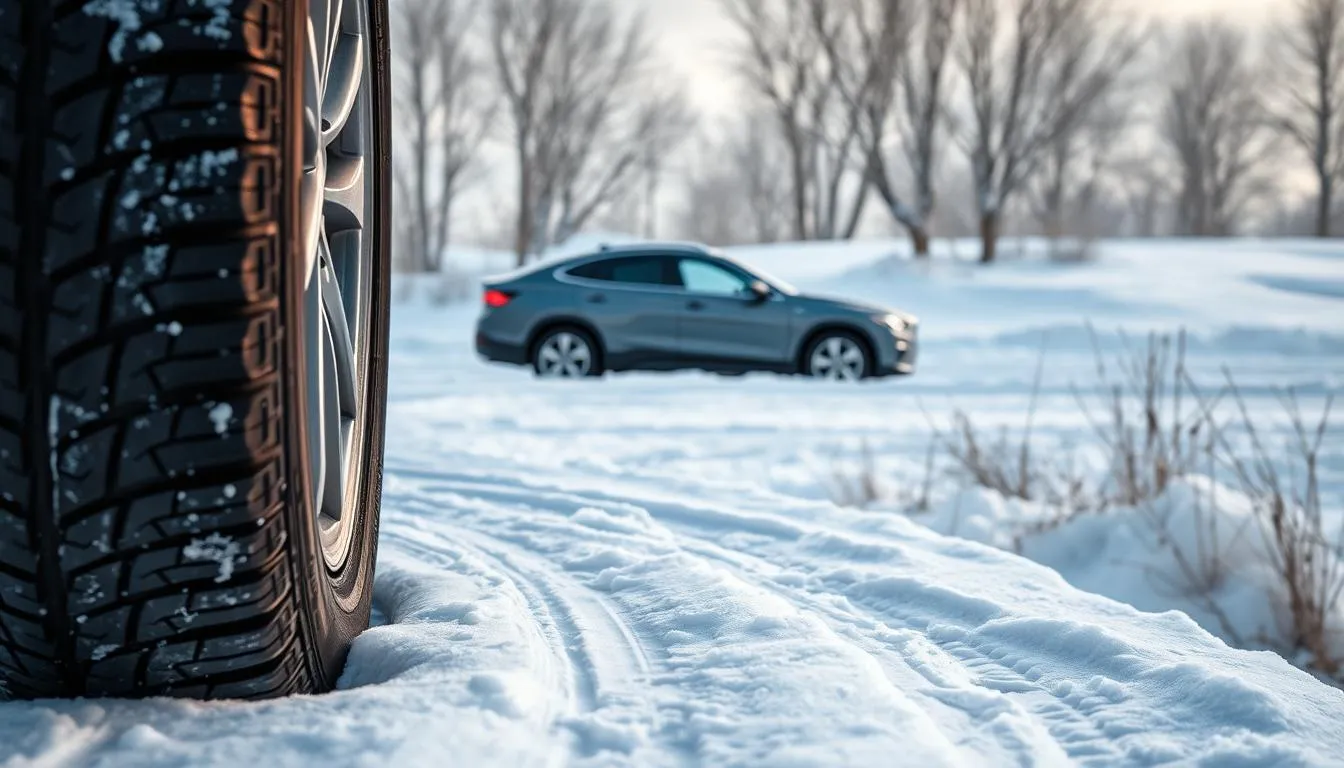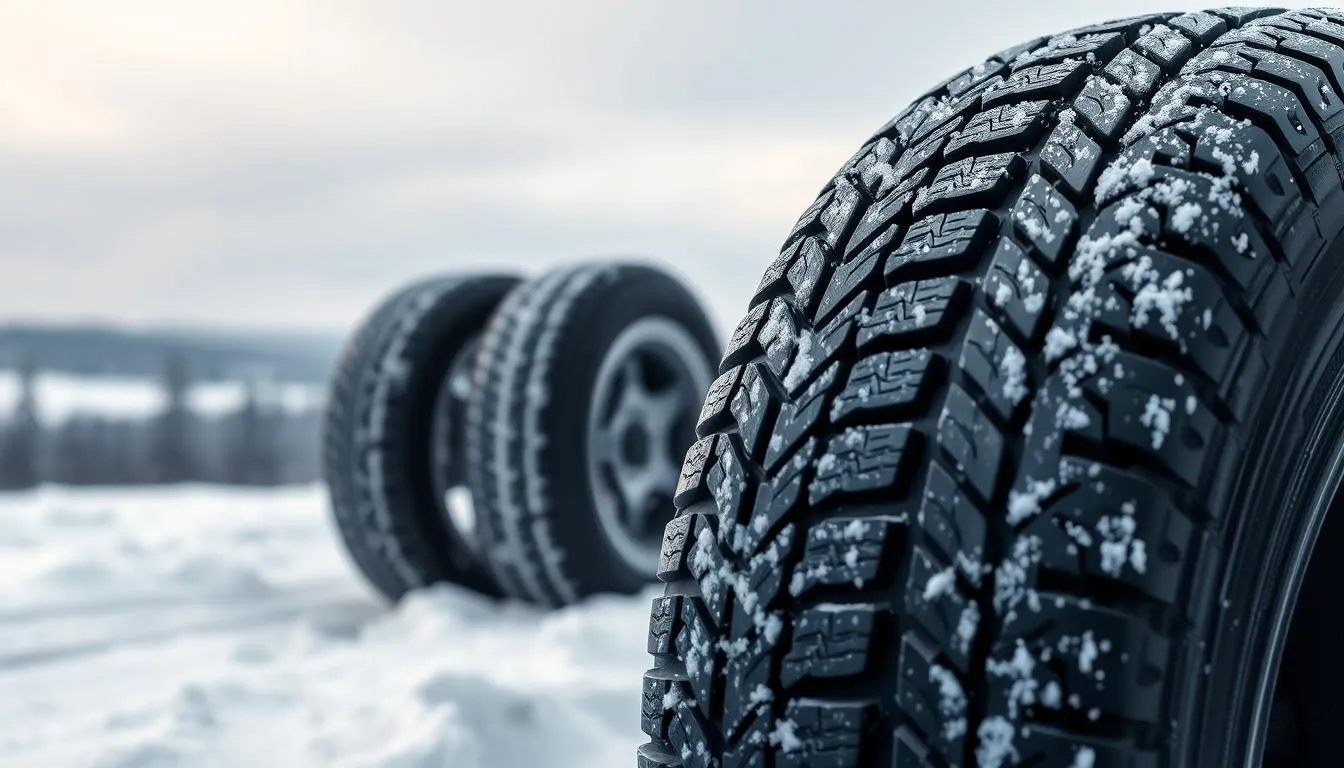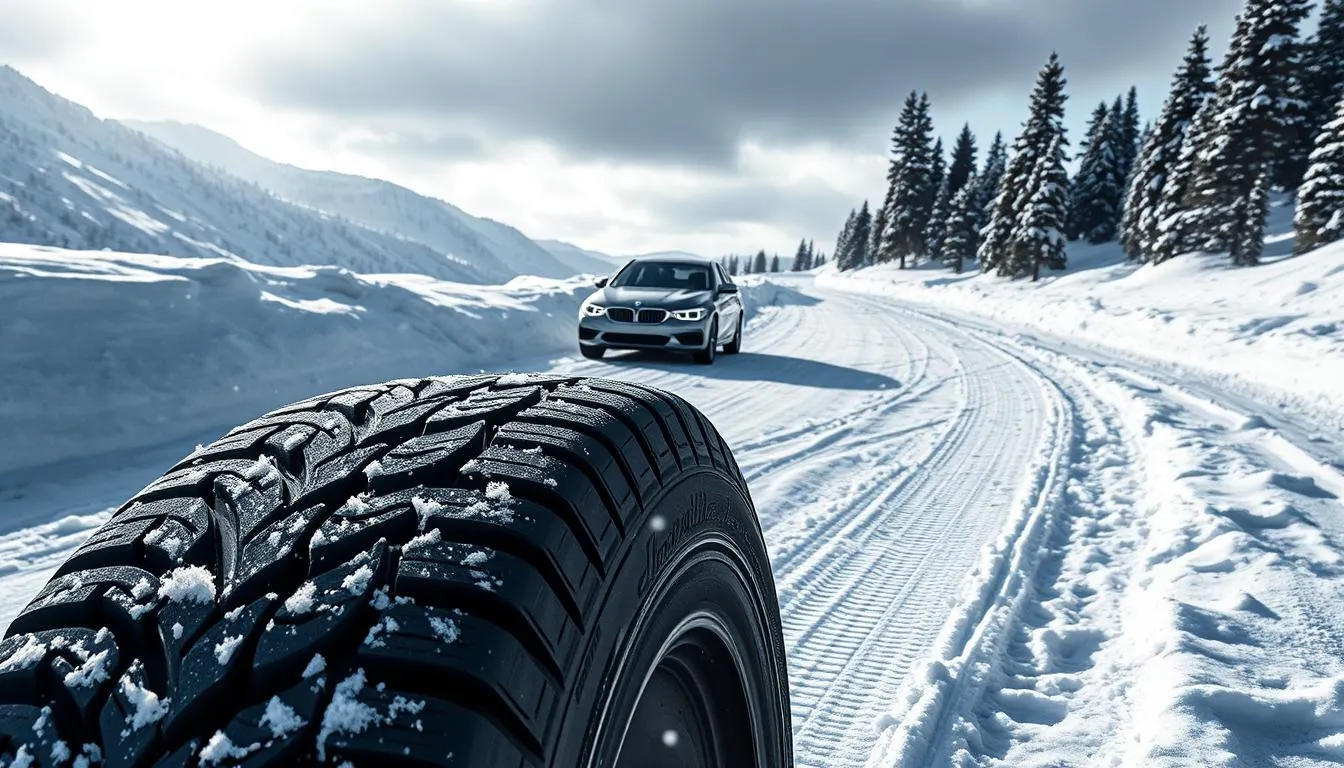As winter comes, I want to help you get your car ready. A good set of winter tires is key for your safety. In this guide, I’ll show you the top winter tires and reviews to pick the best for your car.

First, let’s talk about why a winter tire guide is important. It helps you find the best tires for your car. With many choices, reading reviews can be tough. But with the right guide, you can choose wisely and stay safe.
Key Takeaways
- Investing in a good set of winter tires can significantly improve your safety on the road
- A winter tire guide can help you choose the right tires for your vehicle
- Reading winter tire reviews can help you make an informed decision
- Understanding the key features of winter tires is crucial for making the right choice
- A comprehensive winter tire guide can provide you with the best options and tips for maintaining your tires
Table Of Contents
- 1 Understanding What Makes Winter Tires Different
- 2 Why You Need a Complete Winter Tire Guide
- 3 When to Switch to Winter Tires
- 4 Top Rated Winter Tires for Different Vehicles
- 5 How to Choose the Right Winter Tires
- 6 Premium vs Affordable Winter Tires
- 7 Winter Tire Performance Ratings Explained
- 8 Installing and Storing Winter Tires
- 9 Maintaining Your Winter Tires
- 10 Common Winter Tire Myths Debunked
- 11 How to Get the Best Value for Your Money
- 12 Conclusion
- 13 FAQ
Understanding What Makes Winter Tires Different
Driving in cold weather requires the right tires. As I work on my winter tire buying guide, I’ve found that top rated winter tires offer better traction and control. Their special rubber compounds stay flexible in cold, allowing for better grip and handling.
Comparing winter tires to all-season tires shows their unique tread patterns. These patterns help channel snow and slush away, improving traction and reducing hydroplaning risk. This is crucial in areas with heavy snow or icy roads.
- Special rubber compounds for cold weather flexibility
- Unique tread patterns for improved traction and hydroplaning resistance
- Enhanced grip and handling on snowy and icy roads
Knowing what makes winter tires different helps me choose the right tires for my vehicle. I hope this info helps you too in your winter tire buying guide.
Why You Need a Complete Winter Tire Guide
Exploring winter tires, I see how crucial a winter tire guide is. With so many choices, picking the right tires can feel daunting. A detailed guide helps me understand different types, key features, and make the best choice.
Finding affordable winter tires is key, but it’s not just about cost. It’s about winter tire performance and safety. I need tires that can handle snowy and icy roads safely.
Here are some important things to think about in a winter tire guide:
- Types of winter tires: studless, studded, and hybrid
- Tire size and compatibility with my vehicle
- Tread pattern and depth for optimal traction
- Speed and load ratings for safe operation

By looking at these points and using a detailed winter tire guide, I can find great affordable winter tires. These tires should offer performance, safety, and fit my budget. I want to be sure my car can handle snow and ice well, thanks to the right tires and a good winter tire guide.
When to Switch to Winter Tires
As the temperature drops, it’s crucial to think about switching to winter tires for safe driving. I look for winter tire recommendations from trusted sources. This includes winter tire reviews and ratings from well-known brands.
When deciding when to switch to winter tires, I consider several factors. These include:
- Temperature thresholds: Most winter tire brands suggest switching when the temperature falls below 45°F (7°C).
- Seasonal timing: In places with harsh winters, it’s wise to switch to winter tires in late fall, before the first snow.
- Regional considerations: Drivers in areas with mild winters might not need winter tires. But those in areas with extreme cold and snow should switch earlier.
By looking at these factors and reading winter tire reviews, I can make a smart choice. I can decide when to switch to winter tires and pick the best brands for my vehicle.

Top Rated Winter Tires for Different Vehicles
Choosing the right winter tires for my vehicle can be tough. There are many options, and it’s key to think about tread depth, traction, and how long they last. I look for top rated winter tires that are both good and affordable.
Doing a winter tire comparison helps me decide. I think about my vehicle, how I drive, and where I live. For example, if I drive a car, I might pick affordable winter tires for snowy roads. But if I have a truck or SUV, I might want tires that can handle heavy loads and rough terrain.
Here are some important things to look for in winter tires:
- Tread depth: A deeper tread helps with traction on snowy and icy roads.
- Traction: Look for tires with advanced traction technology, like studs or special tread compounds.
- Durability: Choose tires that are built to last, with strong materials for harsh winter weather.
By looking at these factors and doing a detailed winter tire comparison, I can find the best affordable winter tires for my vehicle. Whether it’s a car, truck, or SUV, there are many top rated winter tires that offer the safety and performance I need for winter driving.
How to Choose the Right Winter Tires
Choosing the right winter tires is crucial for safe driving in cold weather. You need tires that can handle snow and ice well. A good guide can help you pick the best ones for your car.
Look for a guide that includes reviews and ratings. Reading what other drivers say can help you understand how well the tires perform. This is key to making a good choice.

- Vehicle type: Different vehicles need different tires. SUVs and trucks might need more aggressive tread than smaller cars.
- Size and specification: Make sure the tires fit your car perfectly. This means checking size, load rating, and speed rating.
- Budget: Winter tires vary in price. Set a budget and stick to it. Consider the cost of the tires and any extra fees for installation and maintenance.
By thinking about these points and reading reviews, you can pick the best winter tires for your car. Always put safety and performance first when making your choice.
Premium vs Affordable Winter Tires
Choosing the right winter tires can be tough. Drivers often face a choice between premium and affordable options. I look at the pros and cons of each, weighing winter tire performance against cost. Premium tires offer better traction and safety, but they’re pricier. Affordable winter tires are cheaper but still reliable.
Research shows finding a balance between quality and cost is key. While premium tires perform better, affordable ones can still keep you safe on snowy roads. Brands like Michelin and Continental offer options for all budgets and needs.
Here are some key factors to consider when deciding between premium and affordable winter tires:
- Driving conditions: If you live in an area with severe winter weather, premium tires may be worth the investment.
- Vehicle type: Certain vehicles, such as SUVs or trucks, may require more advanced winter tires for optimal performance.
- Budget: Affordable winter tires can be a more cost-effective option for drivers on a tight budget.

The choice between premium and affordable winter tires depends on your needs and budget. By considering your driving conditions, vehicle type, and budget, you can choose the right tires for your car.
Winter Tire Performance Ratings Explained
Choosing the right winter tires is key. I’ll explain how performance ratings help. Traction, speed, and load ratings are all important for safety. Look at winter tire reviews and guides to make a smart choice.
A good buying guide helps you pick the right tires. It considers performance, price, and durability. Reading reviews from other drivers gives you real-world insights. This helps you choose the best tires for your car.

- Traction: The tire’s ability to grip the road, especially on snowy or icy surfaces.
- Speed: The maximum speed at which the tire is designed to operate safely.
- Load: The maximum weight the tire can support, which is critical for vehicles that carry heavy loads.
By looking at these factors and using a buying guide, you can find the perfect tires. Enjoy a safe and smooth drive during winter.
Installing and Storing Winter Tires
As winter gets closer, make sure your car has the right tires for the cold weather. Winter tire installation is key for safe and good driving. Always check the tire pressure to keep it at the level your car maker suggests.
Also, think about winter tire storage. Keep them in a cool, dry spot, away from sunlight and moisture. This keeps the rubber in good shape. Store them upright to avoid flat spots and keep their shape.
Don’t forget about winter tire maintenance. Check the tread depth, look for wear, and make sure they’re balanced and aligned. These steps help your winter tires last longer and drive better all winter.
Some important winter tire maintenance tips include:
- Check tire pressure at least once a month
- Rotate the tires every 5,000 to 8,000 miles
- Look for signs of wear and tear

Maintaining Your Winter Tires
As a car owner, I know how key winter tire maintenance is for safety and performance in the cold. Keeping my winter tires in good shape not only makes them last longer but also improves their winter tire performance. Here, I’ll share some tips to keep your winter tires in top shape.
It’s vital to check tire pressure regularly to avoid uneven wear. I check mine at least once a month and before long drives. I also follow a rotation schedule to ensure even wear. This boosts their winter tire performance and life span.
Watching for wear indicators on my winter tires is also crucial. They tell me when it’s time to replace them, keeping me safe on the road. By sticking to these simple maintenance tips, I get better winter tire performance and a better driving experience. For more info, I suggest looking at winter tire reviews from trusted sources.

- Checking my tire tread depth regularly
- Avoiding overloading my vehicle
- Driving smoothly and avoiding sudden turns
By following these tips and keeping up with my winter tire maintenance, I can have a safe and smooth drive all winter.
Common Winter Tire Myths Debunked
Exploring winter tires, I’ve found many winter tire myths that are misleading. I’ll share winter tire facts to help you choose wisely. Knowing the right tires for winter is key.
Some myths say all-season tires work for winter, or that you only need winter tires in extreme cold. But, winter tire myths can really put you at risk. A good winter tire guide helps you pick the best tires.
Here are important winter tire facts to keep in mind:
- Winter tires offer better grip and control in cold weather
- They use special rubber that stays soft in the cold
- Winter tires can make your drive safer, even in mild winter
Knowing the truth about winter tire myths and using a reliable winter tire guide helps you make smart choices. Always choose safety first by picking the right tires.
How to Get the Best Value for Your Money
Buying winter tires is a big deal. You want to stay safe on the road without spending too much. To get the most value, think about when to buy, look for deals, and understand warranties.
Buying at the right time can save you money. Look for discounts and promotions. Also, consider packages that include installation and maintenance.
It’s important to know about the warranty. Choose tires with a good warranty for peace of mind. This way, you’ll find great deals that fit your budget and needs.
- Research different winter tire packages to find the one that suits your vehicle and driving habits
- Check the winter tire warranty offered by the manufacturer to ensure you’re protected
- Look for discounts and promotions to get the best winter tire deals
By following these tips, you can make a smart choice. You’ll get the best value and stay safe on the road.
Conclusion
Choosing the right winter tire guide is key for driving in cold weather. Understanding winter tires’ unique features is crucial. This helps you stay safe and confident on the road.
Think about your vehicle type, size, and budget when picking the best winter tire reviews. This ensures you get the right tires for your needs.
If you’re starting with snow tires or upgrading, this guide has you covered. It offers winter tire recommendations to help you choose wisely. Stay safe, stay prepared, and enjoy the season with confidence.
FAQ
What makes winter tires different from all-season tires?
Winter tires have special rubber that stays flexible in cold. This gives better grip on snowy and icy roads. Their tread patterns also help push snow and slush away.
When is the best time to switch to winter tires?
Switch to winter tires when it’s below 45°F (7°C). But, the exact time depends on where you live and the weather. Always think about your area’s weather when deciding.
What are the top-rated winter tires for different vehicles?
Many top winter tires are made for cars, trucks, and SUVs. Look at tread depth, traction, and durability to find the best for your vehicle.
How do I choose the right winter tires for my vehicle?
Choosing winter tires needs careful thought. Consider your vehicle’s type, size, and budget. Check your vehicle’s maker’s advice and look at tread, speed, and load ratings.
What are the differences between premium and affordable winter tires?
Premium winter tires have advanced features and better performance but cost more. Affordable ones are cheaper but still good. Think about your budget and driving needs to choose.
How do I properly install and store my winter tires?
Installing and storing winter tires right is key. Check tire pressure, align them properly, and follow the maker’s guide. Store them in a cool, dry place to keep them in good shape.
How do I maintain my winter tires?
Keeping your winter tires in good shape is important. Check tire pressure, rotate them, and watch for wear. Good care extends their life and boosts performance.
What are some common winter tire myths?
Many myths about winter tires are out there. Some say they’re only for heavy snow, or that all-season tires are just as good. But, winter tires are vital for safety, regardless of where you live.
How can I get the best value for my money when purchasing winter tires?
To get the most value for your money, time your purchase right. Look for deals and understand warranties. Smart shopping helps you save.





